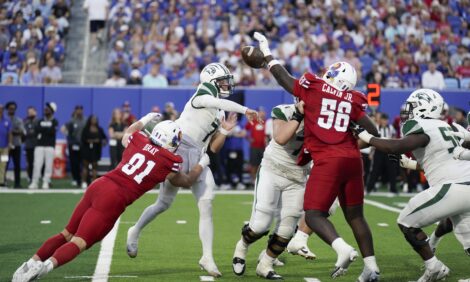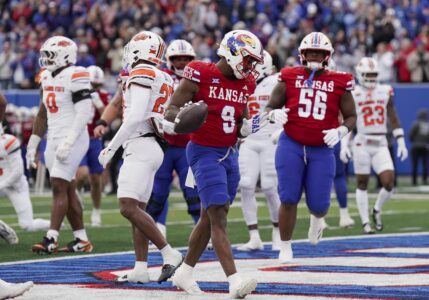David Booth Kansas Memorial Stadium remains ‘on time, on budget’ to complete renovations by August

photo by: Sarah Buchanan/Special to the Journal-World
Kansas athletic director Travis Goff addresses media on a tour of David Booth Kansas Memorial Stadium on Friday, April 25, 2025.
At a guided tour of the ongoing construction of David Booth Kansas Memorial Stadium, University of Kansas athletic director Travis Goff summarized the update in four words: “On time, on budget.”
“(Those are) four words we’re really enjoying continuing to say around here,” Goff said. “They’re working really hard — double shifts, 600 people on site at any given moment, and everything is on track for that August 23 home opener.”
Kansas is completing phase one in a three-phase plan of renovations to David Booth Kansas Memorial Stadium. Phases two and three do not have timelines yet and would not require the stadium to be closed during the football season for renovations, as was the case last season. According to Goff, the stadium is expected to be ready for use “in 98 days.”
Kansas opens its season with a game against Fresno State on Aug. 23, which will be the first game played at David Booth Kansas Memorial Stadium since Nov. 18, 2023.
The only part of the first phase that isn’t expected to be completed by Aug. 23 is the conference center in the northern section of the stadium. However, that won’t impact the game day experience, and Goff said it will be open “in the middle point of the fall.”
“Every other aspect of the stadium will be up and running,” Goff said. “Landscaping in place, the plaza on the northeast entry, World War I Memorial … you name it. It’ll be ready to go as we get into fall.”
The stadium is expected to hold around “40,000-something” and has a lot of new additions on the western and northern sides. That includes seats instead of bleachers, three levels of club suites and a video board around twice the size of the old one. The renovations focused on improving the viewing quality from each seat, and the higher-up western seats are closer to the field than they were previously.
Goff mentioned the desire to create a modern stadium with modern amenities while maintaining a connection to the old architecture and history.

photo by: Sarah Buchanan/Special to the Journal-World
The new team room at David Booth Kansas Memorial Stadium is shown on Friday, April 25, 2025.

photo by: Sarah Buchanan/Special to the Journal-World
Construction work is ongoing at David Booth Kansas Memorial Stadium on Friday, April 25, 2025.

photo by: Sarah Buchanan/Special to the Journal-World
Construction work is ongoing at David Booth Kansas Memorial Stadium on Friday, April 25, 2025.

photo by: Sarah Buchanan/Special to the Journal-World
Construction work is ongoing at David Booth Kansas Memorial Stadium on Friday, April 25, 2025.
Renovations began with the Anderson Family Football Complex, which was extended toward the stadium. The complex has a new auditorium with over 170 seats for the football team and staff. Its glass floor-to-ceiling windows open up and look at the field from the southeast corner, and Goff mentioned the university is looking to potentially rent the space out for large events during games. Connected to the auditorium is a new office for coach Lance Leipold.
Just southeast of the complex is a new video board that is around twice the size of the old one at 5,280 square feet. The video board is also 60 feet closer to the field and was built with the possibility in mind of having video played on the side that faces the hill under the Campanile, too, although it currently isn’t capable of that yet. Goff said the southern side of the video board could be used for concerts, movie nights and other events.
The stadium has three levels with different seating types that are built to cater to different demographics of fans. The west side of the stadium has been raised several feet, so the lowest row isn’t level with the field as it had been before.
Goff believes it will also help boost the revenue generated by the program. Many of the new additions to the stadium came with more club and suite features, which often generate the most money.
“We looked back to revenue generated by football at Kansas, and we went back to the mid-(2010s) or late (2010s) before COVID, and those numbers were more than concerning … they were devastating when you think of the financial opportunity that football provides,” Goff said. “We know that the future performance of what this venue can drive for us financially is profound.”
Goff said construction is now “within striking distance on the core components of the exterior.”
“Now, they’re in the suite spaces, the hospitality and club spaces, finishings, lighting, branding, signage, all those kinds of aspects are still out in front of us,” Goff said.
The crew works Monday through Saturday from 6 a.m. to 2 a.m., with around 600 workers on site during that time. The goal is to complete the first phase by Aug. 1.

photo by: Sarah Buchanan/Special to the Journal-World
Kansas athletic director Travis Goff addresses media on a tour of David Booth Kansas Memorial Stadium on Friday, April 25, 2025.

photo by: Sarah Buchanan/Special to the Journal-World
Construction work is ongoing at David Booth Kansas Memorial Stadium on Friday, April 25, 2025.

photo by: Sarah Buchanan/Special to the Journal-World
Construction work is ongoing at David Booth Kansas Memorial Stadium on Friday, April 25, 2025.

photo by: Sarah Buchanan/Special to the Journal-World
Construction work is ongoing at David Booth Kansas Memorial Stadium on Friday, April 25, 2025.

photo by: Sarah Buchanan/Special to the Journal-World
Construction work is ongoing at David Booth Kansas Memorial Stadium on Friday, April 25, 2025.
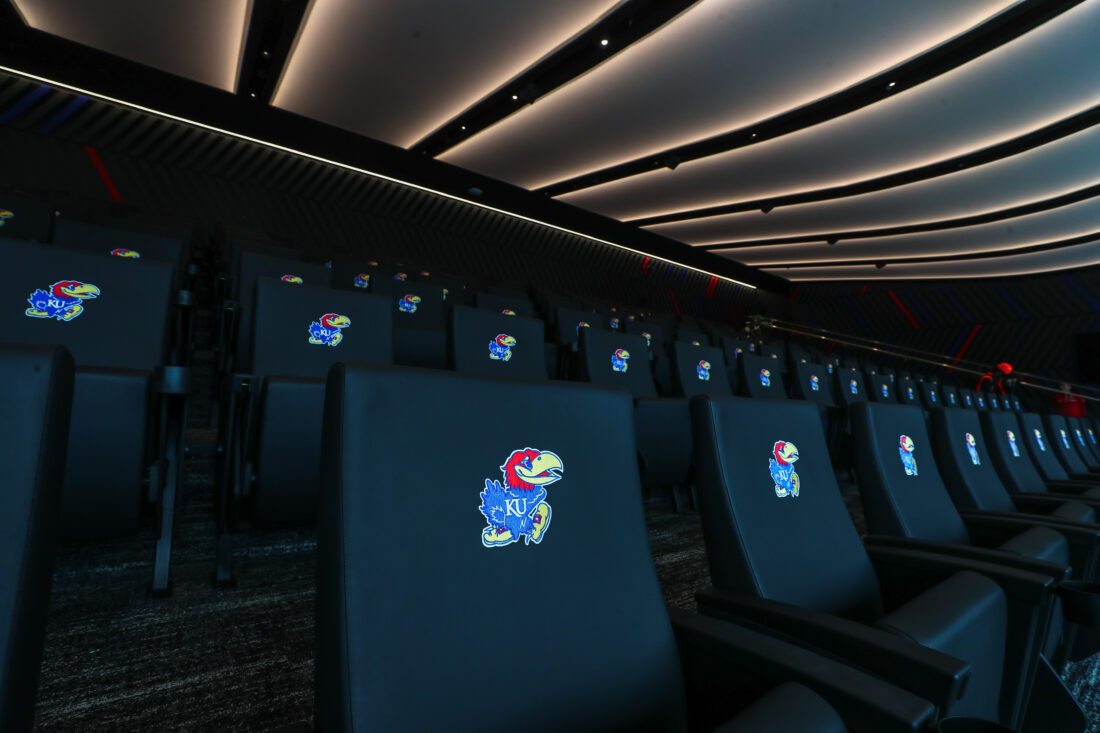
photo by: Sarah Buchanan/Special to the Journal-World
The new team room at David Booth Kansas Memorial Stadium is shown on Friday, April 25, 2025.

photo by: Sarah Buchanan/Special to the Journal-World
The new team room at David Booth Kansas Memorial Stadium is shown on Friday, April 25, 2025.

photo by: Sarah Buchanan/Special to the Journal-World
The new team room at David Booth Kansas Memorial Stadium is shown on Friday, April 25, 2025.

photo by: Sarah Buchanan/Special to the Journal-World
Construction work is ongoing at David Booth Kansas Memorial Stadium on Friday, April 25, 2025.
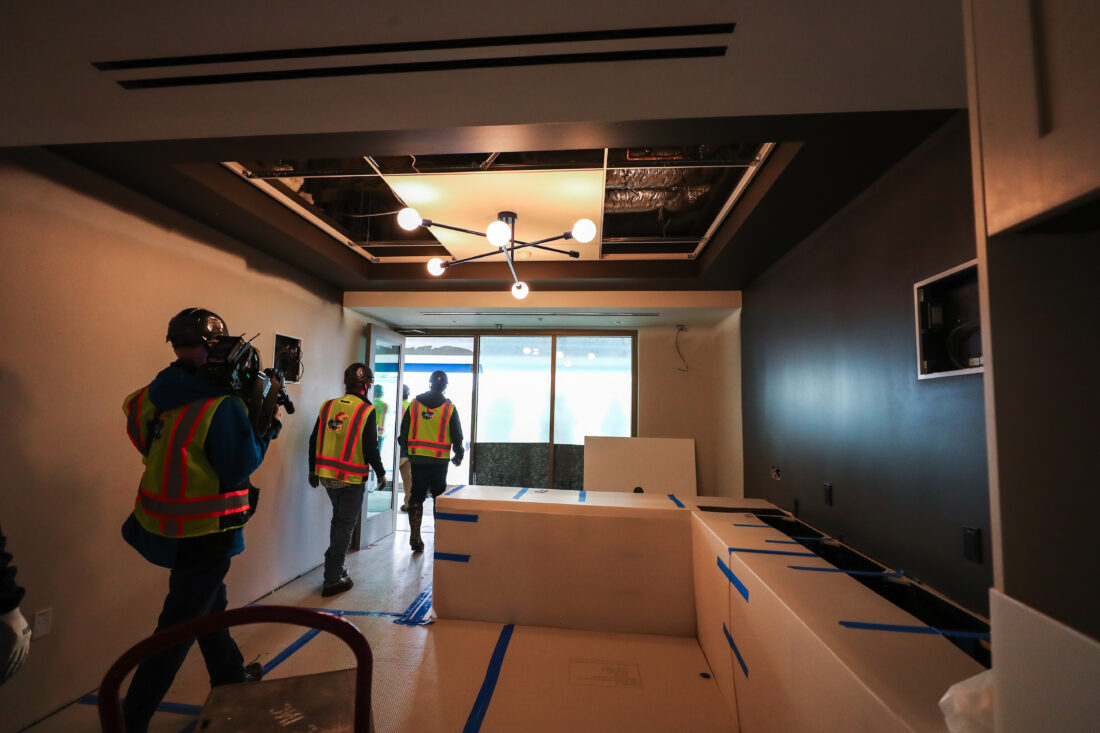
photo by: Sarah Buchanan/Special to the Journal-World
Construction work is ongoing at David Booth Kansas Memorial Stadium on Friday, April 25, 2025.

photo by: Sarah Buchanan/Special to the Journal-World
Construction work is ongoing at David Booth Kansas Memorial Stadium on Friday, April 25, 2025.
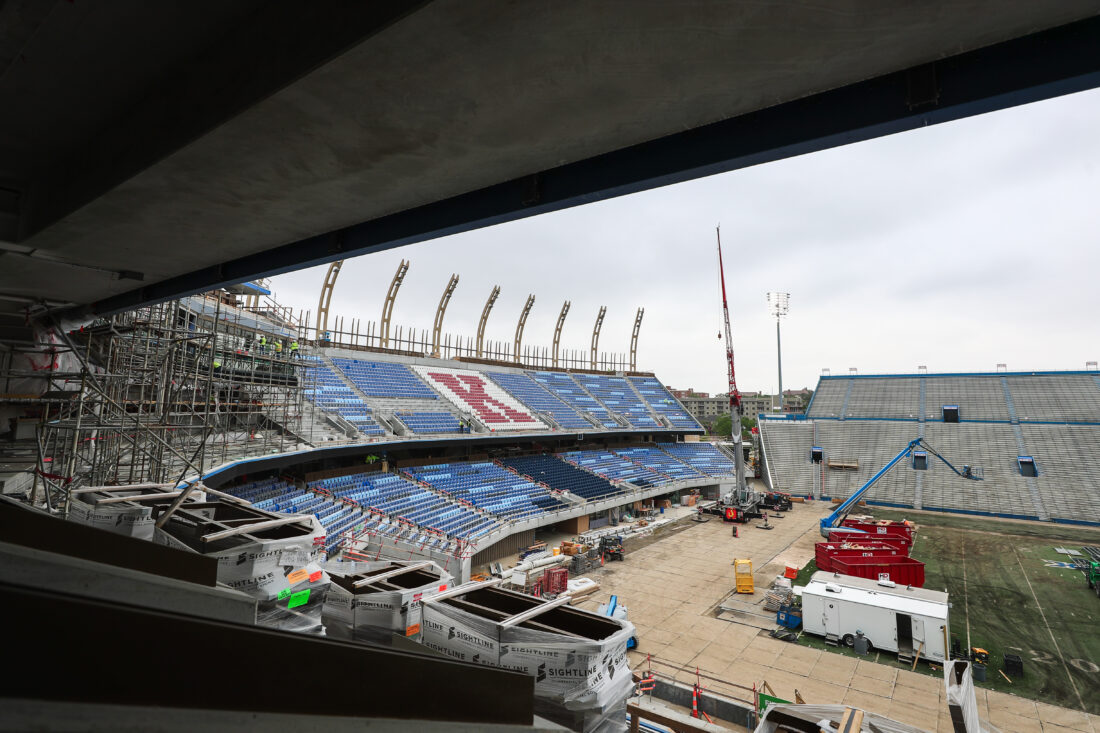
photo by: Sarah Buchanan/Special to the Journal-World
Construction work is ongoing at David Booth Kansas Memorial Stadium on Friday, April 25, 2025.

photo by: Sarah Buchanan/Special to the Journal-World
Kansas athletic director Travis Goff addresses media on a tour of David Booth Kansas Memorial Stadium on Friday, April 25, 2025.
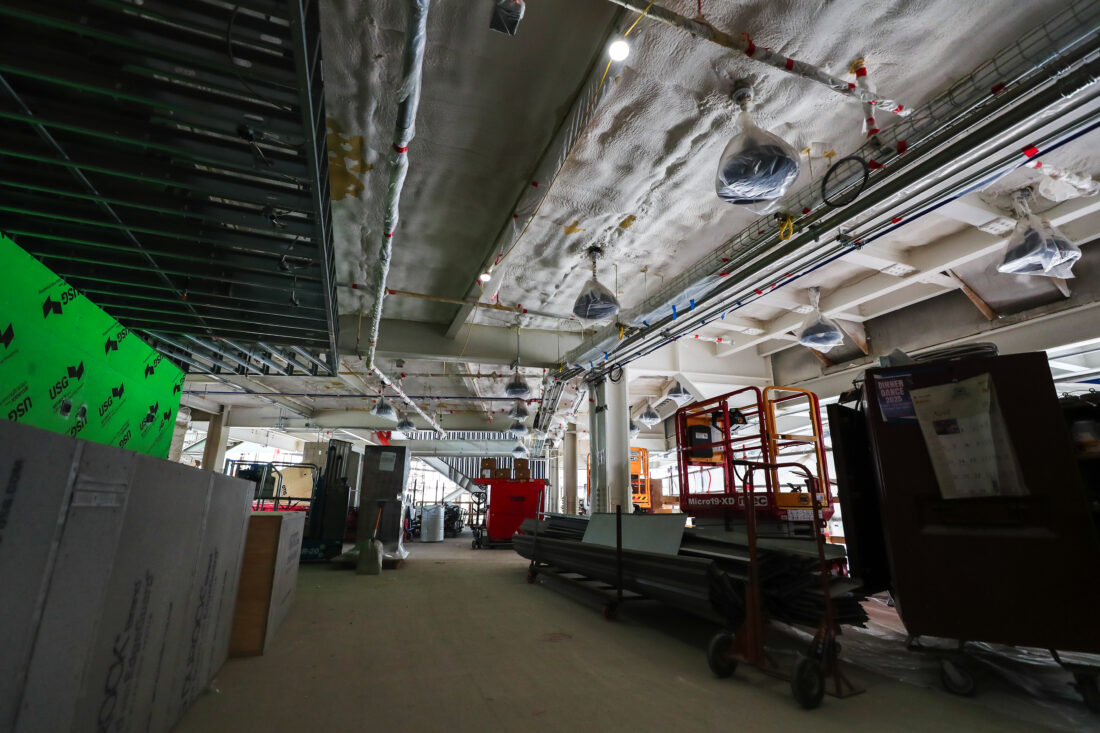
photo by: Sarah Buchanan/Special to the Journal-World
Construction work is ongoing at David Booth Kansas Memorial Stadium on Friday, April 25, 2025.

photo by: Sarah Buchanan/Special to the Journal-World
Construction work is ongoing at David Booth Kansas Memorial Stadium on Friday, April 25, 2025.

photo by: Sarah Buchanan/Special to the Journal-World
Construction work is ongoing at David Booth Kansas Memorial Stadium on Friday, April 25, 2025.

photo by: Sarah Buchanan/Special to the Journal-World
Construction work is ongoing at David Booth Kansas Memorial Stadium on Friday, April 25, 2025.

photo by: Sarah Buchanan/Special to the Journal-World
Construction work is ongoing at David Booth Kansas Memorial Stadium on Friday, April 25, 2025.

photo by: Sarah Buchanan/Special to the Journal-World
Construction work is ongoing at David Booth Kansas Memorial Stadium on Friday, April 25, 2025.

photo by: Sarah Buchanan/Special to the Journal-World
Construction work is ongoing at David Booth Kansas Memorial Stadium on Friday, April 25, 2025.

photo by: Sarah Buchanan/Special to the Journal-World
Construction work is ongoing at David Booth Kansas Memorial Stadium on Friday, April 25, 2025.

photo by: Sarah Buchanan/Special to the Journal-World
Construction work is ongoing at David Booth Kansas Memorial Stadium on Friday, April 25, 2025.

photo by: Sarah Buchanan/Special to the Journal-World
Kansas deputy athletic director Jason Booker addresses media on a tour of David Booth Kansas Memorial Stadium on Friday, April 25, 2025.


